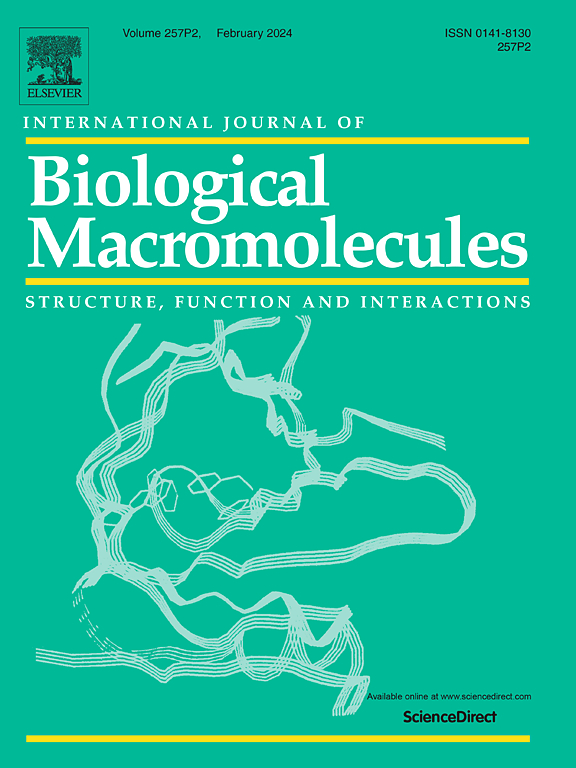Fabricating dehydrated albumen with a novel variable frequency ultrasonic drying method: Drying kinetics, physiochemical and foaming characteristics
IF 8.5
1区 化学
Q1 BIOCHEMISTRY & MOLECULAR BIOLOGY
International Journal of Biological Macromolecules
Pub Date : 2024-12-01
DOI:10.1016/j.ijbiomac.2024.137664
引用次数: 0
Abstract
Albumen, primarily composed of ovalbumin, is a vital, nutrient-rich ingredient in the food industry. Drying is a critical step in low-water-activity albumen powder production, allowing extended shelf-life and reduced costs in handling, transportation, and storage of albumen products. Traditional drying methods, such as spray drying (SD) and hot air drying (HAD), often degrade albumen. This study explores variable frequency contact ultrasonic drying (CUD) as a novel and green alternative, operating at a central frequency of 20 kHz with sound amplitudes of 0 %, 40 %, and 60 %, and temperatures of 40 °C and 60 °C. The drying kinetics, physical, and foaming properties of CUD-dried albumen proteins were compared with those of hot-air-, spray-, and freeze-dried (FD) samples. Compared to HAD, CUD significantly enhanced the drying process, as evidenced by a 240 % increase in effective moisture diffusivity, a 66–78 % reduction in activation energy (Ea), and a 27 % reduction in drying time. Moreover, CUD maintained higher protein integrity, evident from a 24–35 % decrease in enthalpies, more β-turn and random coil structures, and increased free sulfhydryl groups. Notably, CUD at 40 °C significantly improved foaming capacity by 88 %, and at 60 °C, it enhanced foaming stability by 34 %, outperforming other drying methods. Protein solubility of CUD-albumen was improved by 10–12 % compared to HAD and was slightly better than FD. CUD-albumen showed a brighter color with a 26 % lower browning index than the HAD samples. Overall, CUD emerges as an effective and sustainable method for drying high-protein materials, ensuring high-quality albumen powders.
用新型变频超声波干燥法制造脱水白蛋白:干燥动力学、物理化学和发泡特性
蛋白主要由卵白蛋白组成,是食品工业中一种重要的、营养丰富的配料。干燥是生产低水活性蛋白粉的关键步骤,可延长蛋白粉产品的保质期,降低处理、运输和储存成本。传统的干燥方法,如喷雾干燥(SD)和热风干燥(HAD),往往会使蛋白降解。本研究将变频接触式超声波干燥(CUD)作为一种新型的绿色替代方法进行探索,其中心频率为 20 kHz,声幅为 0 %、40 % 和 60 %,温度为 40 °C 和 60 °C。将 CUD 干燥的白蛋白的干燥动力学、物理和发泡特性与热风、喷雾和冷冻干燥(FD)样品的干燥动力学、物理和发泡特性进行了比较。与热风干燥(HAD)相比,CUD 显著增强了干燥过程,具体表现为有效水分扩散率提高了 240%,活化能(Ea)降低了 66-78%,干燥时间缩短了 27%。此外,CUD 还能保持较高的蛋白质完整性,这体现在热焓降低了 24-35%,β-匝和无规线圈结构增多,游离巯基增加。值得注意的是,CUD 在 40 °C 时可显著提高发泡能力 88%,在 60 °C 时可提高发泡稳定性 34%,优于其他干燥方法。与 HAD 相比,CUD-albumen 的蛋白质溶解度提高了 10-12%,略优于 FD。CUD-albumen 的颜色更鲜艳,褐变指数比 HAD 样品低 26%。总之,CUD 是干燥高蛋白材料的一种有效且可持续的方法,可确保得到高质量的蛋白粉。
本文章由计算机程序翻译,如有差异,请以英文原文为准。
求助全文
约1分钟内获得全文
求助全文
来源期刊
CiteScore
13.70
自引率
9.80%
发文量
2728
审稿时长
64 days
期刊介绍:
The International Journal of Biological Macromolecules is a well-established international journal dedicated to research on the chemical and biological aspects of natural macromolecules. Focusing on proteins, macromolecular carbohydrates, glycoproteins, proteoglycans, lignins, biological poly-acids, and nucleic acids, the journal presents the latest findings in molecular structure, properties, biological activities, interactions, modifications, and functional properties. Papers must offer new and novel insights, encompassing related model systems, structural conformational studies, theoretical developments, and analytical techniques. Each paper is required to primarily focus on at least one named biological macromolecule, reflected in the title, abstract, and text.

 求助内容:
求助内容: 应助结果提醒方式:
应助结果提醒方式:


